BLOG
EUROPEAN TIRE LABEL
THE EUROPEAN TIRE LABEL
If you have bought tires in recent years, you have surely noticed a label that reports some of their characteristics, such as their wet grip, fuel efficiency, noise or rolling resistance.
Behind this element, which helps you compare tires more easily, there are some deeper purposes such as promoting road safety and caring for the environment. Its presence in new tires is mandatory throughout the European Union since 2012.
Objectives of European labeling
The mandatory introduction of European labeling responds to certain needs for road transport and also for users.
In the first case, it is about increasing safety, reducing fuel consumption and greenhouse gas emissions. Surely you ask yourself: how can a simple label influence these three important tasks? The answer is simple: this labeling helps to promote those tires that favor both fuel economy and safety, which are two factors linked to outside noise. Let's say that it is responsible for making more visible those covers for which their manufacturers have taken more care in their design and production.
In the case of consumers, this label comes to better inform them about three important characteristics of the tire, such as its grip in the wet (safety), its rolling resistance and fuel efficiency (environment), and its external noise (environment) . This is what makes it easier for you to compare products.
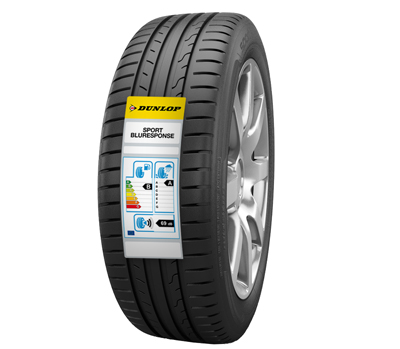
Which tires must have the label?
In general, all tires, both first-equipment and spare, intended for passenger cars (C1), vans (C2) and trucks (C3) must have a label.
There are only a few exceptions, such as motorcycle tires, retreads, off-road professionals, racing tires, those with studs, model T replacement tires, those with a speed rating of less than 80 km / h, those with rim diameters of less than 10 inches or more than 25, and those intended for classic cars that will be mounted on vehicles registered for the first time before October 1, 1990.
Which responsibilities does European labeling entail?
The introduction of this information label places some responsibilities on both tire manufacturers and those who sell them. Since it came into force, there have been some mandatory changes in the communication to the consumer, which has been adapted to the new requirements, in the systems and in the additional tests carried out on the covers.
Sellers must ensure that their passenger car and van tires are clearly labeled, inform their customers during the sale process, and facilitate confirmation on or with the customer's receipt / invoice.
In the specific case of tire manufacturers, it is their responsibility to ensure that all passenger and van tires that arrive at dealers have an adhesive label on the tread with the three specific parameters: wet grip, fuel efficiency and noise level. Or, they must ensure that a printed label with similar characteristics is included with each delivery of one or more identical passenger car or van tires.
Manufacturers must also ensure that such information is detailed in technical promotional materials, both for van and passenger car products and for trucks.
Also, each manufacturer must evaluate and test their own tires. The European Commission is in charge of checking that the values indicated for each parameter are correct.
The leading manufacturers in the market make an important R&D effort every year to offer the best performance in their products and comply with all these specifications. Its tires are always among the most chosen on the market by increasingly informed consumers.
How it is read the European tire label?
First of all, you must bear in mind that the European tire label, which is how this element is known, consists of two parts: one that is determined by the European Commission and that refers to the parameters of wet grip, fuel efficiency and Noise level; and another in which the manufacturer can include the information they want related to the cover, for example its size, segment or brand.
Here we are going to refer to the information that shows the part of the label that the European Commission determines and that you can see explained in the following image:
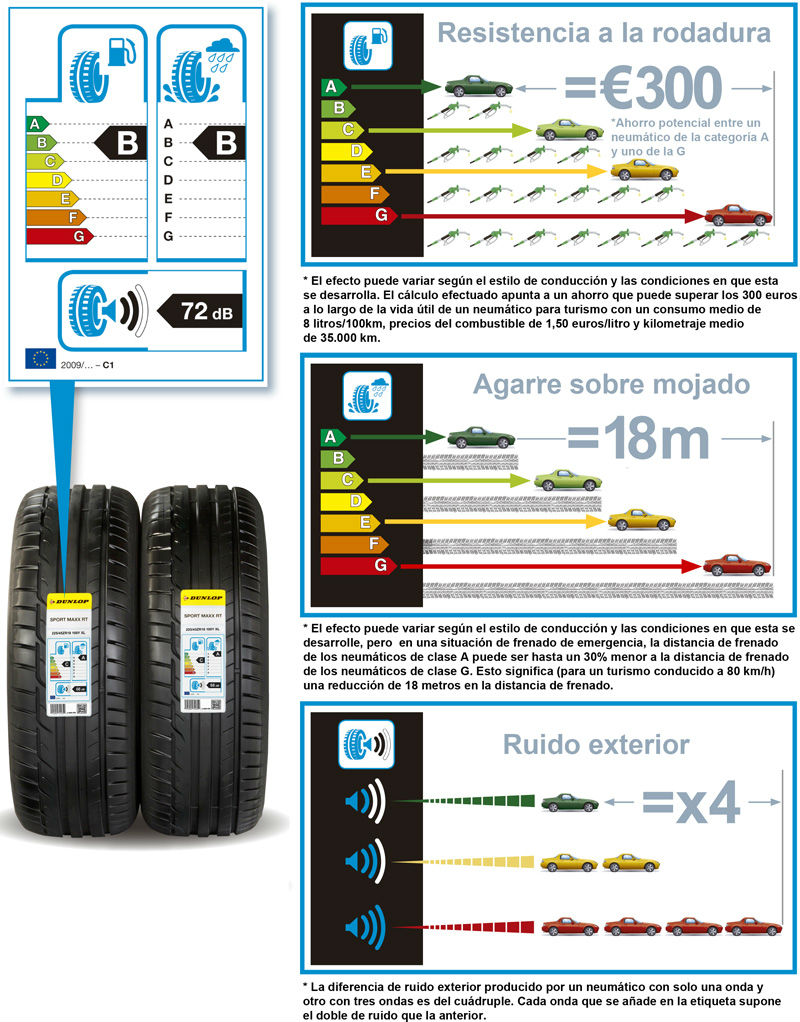
Next we are going to talk in depth about each of the parameters that this part of the European tire label deals with so that you can know them well when reading it:
- Rolling resistance: To calculate the fuel-saving potential of a tire, the concept of rolling resistance is used, which refers to that exerted by the tire when rotating against the ground. This is done because the fuel efficiency of a tire depends on this parameter: a tire with lower rolling resistance requires less energy (and therefore less fuel) to roll. In fact, the influence of the covers represents around 20% of the fuel consumption of a vehicle.
There are seven different classes, from G, which is the lowest fuel efficiency class, to A, which is the most fuel efficient class. The difference between the fuel consumption of a vehicle with four A-class tires and the same vehicle with four G-class tires can be as high as 7.5%.
If we count it in absolute values, this represents a saving of more than 300 euros throughout the life of a touring tire, if we consider an average consumption of 8 liters / 100km, fuel prices of 1.50 euros / liter and average mileage of 35,000 km. In the case of a truck tire, the savings would be more than 5,000 euros, if we estimate an average consumption of 30 liters / 100km, fuel prices of 1.30 euros / liter and an average mileage of 180,000 km.
Of course, you should not lose sight of the fact that there are other factors that influence fuel consumption, such as driving style, tire inflation pressure and the maintenance that you carry out on your vehicle in your trusted workshop.
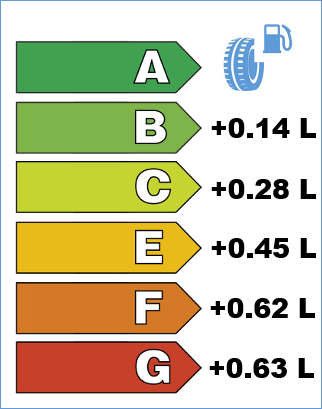
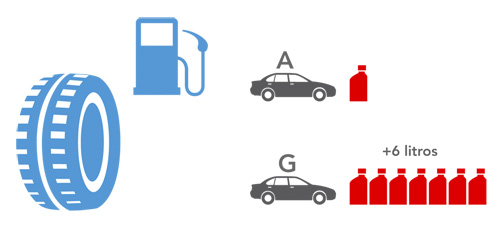
- Wet grip: This parameter describes the ability of a tire to grip the road when the surface is wet and is measured by analyzing the stopping distance under these conditions. As in the previous case, it is also divided into seven classes: G applies to the tires with the longest stopping distance and A, with those that provide the shortest. The difference between A and G is 18 meters, which is the same as the width of four cars, or eight Smart cars lined up.


The tires with great grip on wet provide, apart from a reduction in braking distance on wet roads, better handling in these conditions, as well as greater stability in curves and better handling. Even so, the European labeling is only based on wet braking performance.
In an emergency braking situation, the stopping distance of class A tires can be up to 30% less than that offered by class G tires. This means (for a car driven at 80 km / h) a reduction of 18 meters in that distance. For a typical truck driven at 80 km / h this could mean up to 25 meters shorter stopping distance.

In Europe, G-rated tires in this attribute are no longer accepted.
- Exterior noise: This section refers to the external rolling noise that occurs when the tire is in contact with the road. Noise is expressed in decibels and is accompanied by a pictogram that indicates whether it is higher or lower than the European limit.
You should bear in mind that the profile of the tire (that is, the arrangement of the profile blocks) has a considerable influence on the noise produced by the tire. You should also know that the noise that the tire produces is different on the outside and on the inside, and that the European label focuses on the outside.
On the label, noise is expressed by two different parameters: its value in decibels and a pictogram with one, two or three black waves. A single black wave indicates that you will be facing a silent tire, that is, that the noise emission level of the tire is at least 3 dB below the European legal limit. Two black waves indicate an average behavior, in which the noise emission level of the tire does not exceed 3 dB below the legal limit. Three black waves correspond to the loudest behavior, since the noise emission level of the tire is between the current maximum value and the legal limit
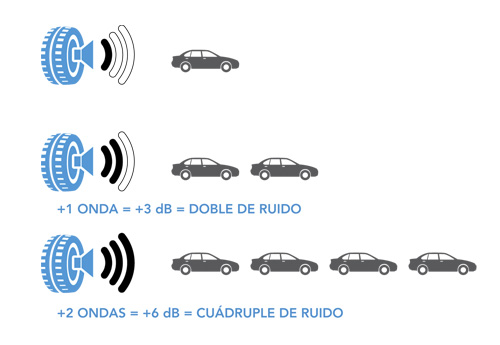
vs oct 2021
Related Articles
Tires: have them expiration date?The first thing is to establish that the expiration
date is not the same as the life of a tire. The tires do not have an
established expiration d...
TIRE TECH: TIRE SIZE GUIDEThe tire size branded on the sidewall provides a significant amount of
information about the tire's intended purpose, dimensions, load capacity and
...

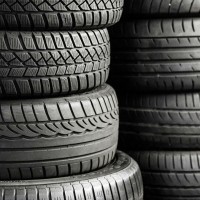
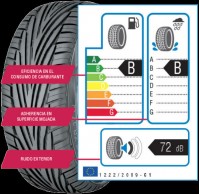
Leave your comment